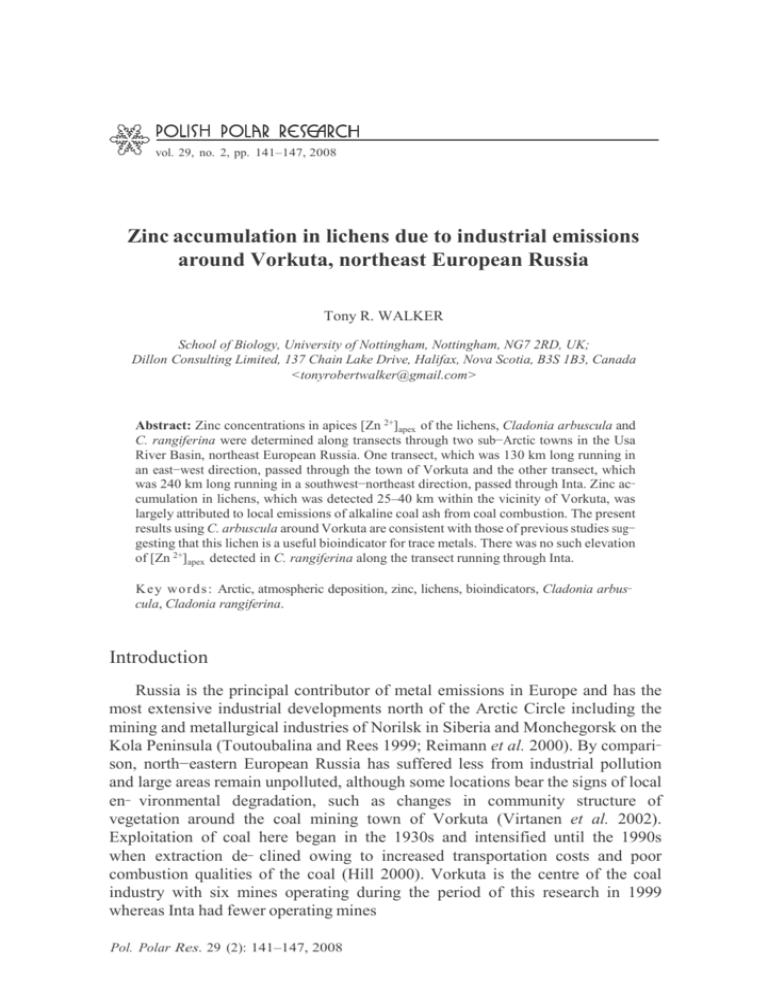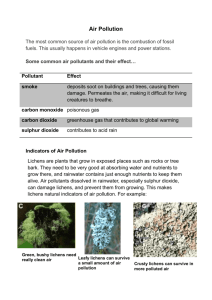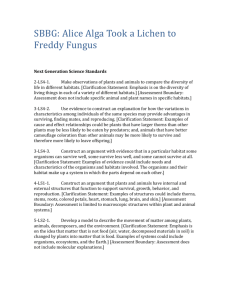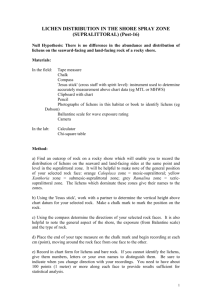Zinc accumulation in lichens due to industrial emissions around
advertisement

vol. 29, no. 2, pp. 141–147, 2008 Zinc accumulation in lichens due to industrial emissions around Vorkuta, northeast European Russia Tony R. WALKER School of Biology, University of Nottingham, Nottingham, NG7 2RD, UK; Dillon Consulting Limited, 137 Chain Lake Drive, Halifax, Nova Scotia, B3S 1B3, Canada <tonyrobertwalker@gmail.com> Abstract: Zinc concentrations in apices [Zn 2+]apex of the lichens, Cladonia arbuscula and C. rangiferina were determined along transects through two sub−Arctic towns in the Usa River Basin, northeast European Russia. One transect, which was 130 km long running in an east−west direction, passed through the town of Vorkuta and the other transect, which was 240 km long running in a southwest−northeast direction, passed through Inta. Zinc ac− cumulation in lichens, which was detected 25–40 km within the vicinity of Vorkuta, was largely attributed to local emissions of alkaline coal ash from coal combustion. The present results using C. arbuscula around Vorkuta are consistent with those of previous studies sug− gesting that this lichen is a useful bioindicator for trace metals. There was no such elevation of [Zn 2+]apex detected in C. rangiferina along the transect running through Inta. K e y w o r d s : Arctic, atmospheric deposition, zinc, lichens, bioindicators, Cladonia arbus− cula, Cladonia rangiferina. Introduction Russia is the principal contributor of metal emissions in Europe and has the most extensive industrial developments north of the Arctic Circle including the mining and metallurgical industries of Norilsk in Siberia and Monchegorsk on the Kola Peninsula (Toutoubalina and Rees 1999; Reimann et al. 2000). By compari− son, north−eastern European Russia has suffered less from industrial pollution and large areas remain unpolluted, although some locations bear the signs of local en− vironmental degradation, such as changes in community structure of vegetation around the coal mining town of Vorkuta (Virtanen et al. 2002). Exploitation of coal here began in the 1930s and intensified until the 1990s when extraction de− clined owing to increased transportation costs and poor combustion qualities of the coal (Hill 2000). Vorkuta is the centre of the coal industry with six mines operating during the period of this research in 1999 whereas Inta had fewer operating mines Pol. Polar Res. 29 (2): 141–147, 2008 142 Tony R. Walker in 1998 and a comparatively smaller coal mining industry. Coal mining and com− bustion for power generation have been the principal sources of heavy metal pollu− tion in the region; with Vorkuta being the highest emitter and suffering a legacy of pollution impacts resulting from the deposition of alkaline fly ash (Solovieva et al. 2002; Walker et al. 2003a, b; Walker 2005). An inventory of pollutants emitted from both towns has been summarized by Solovieva et al. (2002). Mat−forming terricolous lichens are important components of plant communi− ties in high latitudes, where they contribute to nutrient cycling and secondary pro− duction, such as grazing (Longton 1997). Lichens are primarily dependant on at− mospheric sources for nutrients and therefore readily accumulate atmospheric contaminants, such as metals (Nash and Gries 1995). Therefore, they are amongst the most pollution sensitive receptors in terrestrial ecosystems (Richardson 1988). Spatial variation in the chemical composition of lichens has been widely used to monitor environmental quality as a result of industrial activities including situated around coal−fired power stations (Gonzalez and Pignata 1997; Walker and Pystina 2006; Walker et al. 2006a). The principle source of electrical power used in the town in this study is generated by coal−fired power stations. The present research aimed at assessing the extent of zinc deposition due to lo− cal sources around Vorkuta and Inta in the Komi Republic, northeast European Russia using the lichens Cladonia arbuscula and C. rangiferina along a transect passing through both towns. This region spans the sub−Arctic taiga forest and tun− dra ecotones and has already been identified as a significant source of metal emis− sions mainly as a result of coal fired power stations in the towns of Vorkuta and to a lesser extent Inta (Solovieva et al. 2002; Walker et al. 2003a, b; Walker 2005; Walker et al. 2006b). The study provided an opportunity to further evaluate the use of terricolous lichens as bioindicators of metal deposition (Walker et al. 2003b, 2006a). Materials and methods Transects for sampling lichens were establishe d that passed through the towns of Vorkuta (67 30’N, 64 05’E) and through Inta (66 03’N, 60 10’E). Inta was chosen for the second transect study because it also has a large coal industry and is currently the second most largest coal producing town in the region. These sampling locations and transects have been illustrated and described in greater detail elsewhere (see Fig. 1; Walker et al. 2003a, b). The transect passing through Vorkuta was approxi− mately 130 km long and oriented west−east; characterized by Betula nana L. shrub tundra along its entire length. The transect passing through Inta was 240 km long and oriented southwest−northeast spanning taiga forest and tundra ecotones. Mean an− nual precipitation for Vorkuta and Inta is 518 and 473 mm respectively and south westerly winds prevail in the region. Zinc accumulation in lichens 143 Fig. 1. Pechora region showing sampling transects through the towns of Vorkuta and Inta. Six sampling sites were selected along each of the transects. Originally nine sampling sites had been chosen along the Inta transect (reflecting its greater length) but the availability of C. rangiferina along this transect was limited partly due to the lack of suitable lichen heath habitat in the area. At each site, three sub−sites were selected, 1 km apart, at which six replicate samples of lichen were collected at distances 10–20 m apart in open areas in order to minimize tree canopy effects; these were usually inter−tree positions in open forest, or in tundra. Most sites were in wilderness areas remote from roads. Terricolous mat−forming lichens C. arbuscula (Wallr.) Flot. and C. rangiferina (L.) F.H.Wigg. were collected at sub−sites to provide biomarkers for atmospheric deposition and because of their abundance in shrub tundra and taiga forest. Lichen samples were air−dried in the field, sealed in LDPE containers and stored at 4 C until analysis. Powder−free LDPE gloves were worn when handling lichens in the field and the laboratory to minimise contamination. Lichens were rehydrat ed overnight by exposure to wa− ter−saturated air (over water in a desiccator) at 4 C, then fully saturated by spray− ing lightly with deionised water and cleaned of extraneous debris using forceps. Samples were dried overnight at 80 C and then weighed, where c. 100 mg of api cal (5 mm) tissue was digested to dryness in 1 mL of concentrated HNO3 at 175 C. The residue was dissolved in 10 mL 1 M HNO3 and appropriate quantities of ionis− ation suppressant and releasing agent (CsC12, LaC12) added. Zinc was selected be− cause it was one of several trace metals found to contaminate snow and soils lo− 144 Tony R. Walker cally in the survey region (see Walker et al. 2003a; Walker 2005) and was mea− sured by flame atomic absorption spectrophotometry (FAAS); concentrations were recalculated in relation to the mass of dried apical lichen tissue to allow direct comparison with the solution data (see Walker et al. 2003b). Genstat and Minitab were used to perform standard statistical analyses (ANOVA, correlation analysis and linear regression). Results and discussion Collections of C. arbuscula was complete at all six sites along the Vorkuta transect despite mat−forming lichen cover being generally poor in the region due to heavy grazing and trampling by reindeer (Crittenden 2000). Along the Inta transect collections of C. rangiferina were made as C. arbuscula was less abun− dant along this transect. Whilst no attempt was made to compare absolute concen− trations between the two lichen species they were chosen based on their availabil− ity along each transect. Therefore the results of this study may be used as a proxy for indicating localized perturbations of Zn concentrations. There was significant localized higher [Zn2+]apex in C. arbuscula in the vicinity of Vorkuta (P <0.001). For example the highest concentration of [Zn2+]apex in C. arbuscula were found at the two sites closest to the town (see Fig. 2a). Previous studies found no such local− ized elevated concentrations in [Zn2+]apex in C. stellaris around Inta, but it was strongly related to latitude (Walker et al. 2003b). It is possible that the apparent lack of any Zn perturbation around Inta may be due to lower sampling density T ab le 1 2+ Comparison of [Zn ]apex (μg g−1) in Cladonia spp. from high latitude industrial and pristine areas. Grey shading indicates industrial areas Vorkuta (Transect) (coal mining) Inta, NE European Russia (coal mining) Inta, NE European Russia (coal mining) [Zn] −1 (μg g ) C. arbuscula 16–55 C. rangiferina 15–34 C. stellaris 9–32 Gusum, Sweden (steel foundry) C. rangiferina Location SE Ohio, USA (coal mining) Ontario, Canada, Uranium mines (0.5–30 km) Delaware Gap, USA (zinc smelter) Northwest Territories, Canada Northwest Territories, Canada Bellsund area, Spitsbergen High Point Park, New Jersey, USA Species Cladonia sp. Study This study This study Walker et al. (2003b) Folkeson and 55–75 Andersson−Bringmark (1988) 27–42 Lawrey and Rudolf (1975) C. mitis 13–22 Fahselt et al. (1995) Cladonia sp. Cladonia sp. Cladonia sp. Cladonia sp. C. rangiferina 61–80 7–55 16–25 29–39 7–16 Nash (1975) Puckett (1978) Puckett and Finegan (1980) Jóźwik (1990) Glenn et al. (1991) 145 Zinc accumulation in lichens a 0.9 W E 0.8 0.7 0.6 Vorkuta 0.5 0 20 40 60 80 100 120 140 Distance (km) b 0.4 N S 0.3 Inta 0.2 0 50 100 150 200 250 Distance (km) Fig. 2. Variation in [Zn 2+]apex in Cladonia arbuscula ( ) along the transect passing through Vorkuta (a) and C. rangiferina ( ) along the transect passing through Inta (b). Plotted values are means ±1 SE (n = 18). Note the different scales used for both plots. along this transect, although local collections of C. rangiferina were attempted, their availability was scarce. Despite the lower sampling density along the Inta transect collections of C. rangiferina around Inta (Fig. 2b) did not show an appar− ent relationship between [Zn2+]apex and latitude unlike collections of C. stellaris in a previous study (Walker et al. 2003b). Variation in [Zn2+]apex in C. arbuscula around Vorkuta correlates well with other pollution signals from earlier work re− lating to snow ([SO42−]snow, [Ca2+ ]snow, [K+]snow, pH); metal contamination in soil and [N]apex in lichens (r = 0.90, P <0.01, n = 6) (Walker et al. 2003a, b). The concentration ranges presented in Table 1 are in broad agreement with previous studies but any discrepancies may reflect physiological differences be− tween lichens or method of analyses. Therefore, it was not the intent of this study to make direct inter comparisons of Zn concentrations between different species but rather to use Zn concentrations in lichens as a proxy to detect elevated levels around industrial sites. The lowest concentrations of [Zn2+]apex were comparable with other studies in pristine locations (see Table 1), whilst elevated concentra− 146 Tony R. Walker tions around Vorkuta in this study were as high as concentrations found in other Cladonia spp. around coal mining towns (Walker et al. 2003b; Lawrey and Rudolf 1975). According to Folkeson and Andersson−Bringmark (1988), [Zn2+]apex mea− sured in C. rangiferina sampled 6–7 km away from steel foundries in Gusum, Sweden were 55–75 μg g−1 whilst the first indication of a reduced ground cover for this lichen species was only observed when the [Zn2+]apex exceeded 500 μg g−1. Therefore, they suggested that a [Zn2+]apex limit of 600 μg g−1 would indicate the ap− parent critical threshold concentration (fatal concentration) for survival of C. rangiferina. The [Zn2+]apex observed around Vorkuta in this study fall far below the thresholds reported by Folkeson and Andersson−Bringmark (1988) and the con− centrations reported here are therefore likely not to cause damage to these lichens. Terricolous mat−forming lichens are abundant throughout the sub−Arctic tun− dra and taiga regions and are sentinel species that readily accumulate contaminants that reflect local environmental conditions due to their slow growth and physiol− ogy. The present results using C. arbuscula around Vorkuta are consistent with those of previous studies suggesting that they are useful bioindicators for trace metals. While there occurs a clear Zn peak in the town of Vorkuta, Inta is not marked by a Zn anomaly. The anthropogenic Zn peak in C. arbuscula around Vorkuta is attributed to local deposition of coal ash from coal combustion extend− ing 25–40 km around Vorkuta. Acknowledgements. — This investigation was a contribution to TUNDRA (TUNdra Deg− radation in the Russian Arctic) supported by the Environment and Climate Programme of the European Commission (contract ENV4−CT97−0522). We are grateful to our Russian colleagues at the Komi Science Centre, Institute of Biology, Syktyvkar and Peter Kuhry for co−ordinating the project. References CRITTENDEN P.D. 2000. Aspects of the ecology of mat−forming lichens. Rangifer 20: 127–139. FAHSELT D., WU T−W. and MOTT B. 1995. Trace element patterns in lichens following uranium mine closures. The Bryologist 98: 228–234. FOLKESON L. and ANDERSSON−BRINGMARK E. 1988. Impoverishment of vegetation in a coniferous forest polluted by copper and zinc. Canadian Journal of Botany 66: 417–428. GLENN M.G., ORSI E.V. and HEMSLEY M.E. 1991. Lichen metal contents as correlates of air filter measurements. Grana 30: 44–47. GONZALEZ C.M. and PIGNATA M.L. 1997. Chemical response of the lichen Punctelia subrudecta (Nyl.) Krog transplanted close to a power station in an urban−industrial environment. Environ− mental Pollution 97: 195–203. HILL M.R. 2000. Technological options for the reduction of Russian acid rain and greenhouse gas emissions. Environmental Planning B 27: 393–410. JÓŹWIK Z. 1990. Heavy metals in tundra plants of Bellsund area, Spitsbergen. Polish Polar Research 11: 401–409. LAWREY J.D. and RUDOLPH E.D. 1975. Lichen accumulation of some heavy metals from acidic surface substrates of coal mine ecosystems in Southeastern Ohio. The Ohio Journal of Science 75: 113–117. 147 Zinc accumulation in lichens LONGTON R.E. 1997. The role of bryophytes and lichens in polar ecosystems. In: S.J. Woodin and M. Marquiss (eds) Ecology of Arctic Environments. Blackwell Science, Cambridge University Press, Cambridge: 69–96. NaSH T.H. III. 1975. Influence of effluents from a zinc factory on lichens. Ecological Monographs 45: 183–198. NASH T.H. III. and GRIES C. 1995. The use of lichens in atmospheric deposition studies with an em− phasis on the Arctic. The Science of Total Environment 160/161: 729–736. PUCKETT K.J. and FINEGAN E.J. 1980. An analysis of the element content of lichens from the North− west Territories, Canada. Canadian Journal of Botany 58: 2073–2089. REIMANN C., BANKS D. and CARITAT P. De 2000. Impacts of airborne contamination on regional soil and water quality: The Kola Peninsula, Russia. Environmental Science and Technology 34: 2727–2732. RICHARDSON D.H.S. 1988. Understanding the pollution sensitivity of lichens. In: D.H. Dalby, D.L. Hawksworth and S.L. Jury (eds) Horizons in Lichenology. Academic Press, London: 31–43. SALMINEN R., CHEKUSHIN V., TENHOLA M., BOGATYREV I., GLAVATSKIKH S.P., FEDOTOVA E., GREGORAUSKIENE V., KASHULINA G., NISKAVAARA H., POLISCHUOK A., RISSANEN K., SLENOK L., TOMILINA O. and ZHDANOVA L. 2004. Geochemical Atlas of Eastern Barents Re− gion. Elsevier, Amsterdam; 548 pp. SOLOVIEVA N., JONES V.J., DAUVALTAR V., APPLEBY P.G. and KONDRATENOK B.M. 2002. Ex− tent, environmental impact and long−term trends in atmospheric contamination in the Usa basin of East−European Russian Arctic. Water, Air, and Soil Pollution 139: 237–260. TOUTOUBALINA O.V. and REES G.W. 1999. Remote sensing of industrial impact on Arctic vegeta− tion around Noril’sk, northern Siberia: preliminary results. International Journal of Remote Sensing 20: 2979–2990. VIRTANEN T., MIKKOLA K., PATOVA E. and NIKULA A. 2002. Satellite image analysis of human caused changes in the tundra vegetation around the city of Vorkuta, north−European Russia. En− vironmental Pollution 120: 647–658. WALKER T.R. 2005. Comparison of anthropogenic metal deposition rates with excess soil loading from coal, oil and gas industries in the Usa Basin, NW Russia. Polish Polar Research 26: 299–314. WALKER T.R. and PYSTINA T.N. 2006. The use lichens to monitor terrestrial pollution and ecological impacts caused by oil and gas industries in the Pechora Basin, NW Russia. Herzogia 19: 229–238. WALKER T.R., CRITTENDEN P.D. and YOUNG S.D. 2003b. Regional variation in the chemical com− position of winter snowpack and terricolous lichens in relation to sources of acid emissions in the Usa River basin, northeast European Russia. Environmental Pollution 125: 401–412. WALKER T.R., YOUNG S.D., CRITTENDEN P.D. and ZHANG H. 2003a. Anthropogenic metal enrich− ment of snow and soil in north−eastern European Russia. Environmental Pollution 121: 11– 21. WALKER T.R., CRITTENDEN P.D., YOUNG S.D. and PRYSTINA T. 2006a. An assessment of pollution impacts due to the oil and gas industries in the Pechora basin, north−eastern European Russia. Ecological Indicators 6: 369–387. WALKER T.R., HABECK O., KARJALAINEN T.P., VIRTANEN T., SOLOVIEVA N., JONES V., KUHRY P., POMONOROV V.I., MIKKOLA K., NIKULA A., PATOVA E., CRITTENDEN P.D., YOUNG S.D. and INGOLD T. 2006b. Perceived and measured levels of environmental pollution: Interdisci− plinary research in the subarctic lowlands of northeast European Russian. Ambio 35: 220–228. Received 21 April 2008 Accepted 19 May 2008








